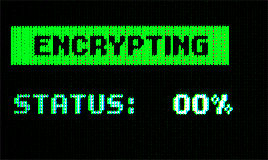 Today I read Chapter 16 Cryptographic Concepts in my CompTIA Security+ Exam SYO-601 Exam Guide book and I watched Professor Messer videos on Youtube. I know Cryptography is one of my weaker areas so I plan to utilize quite a few resources. I'll study this area for a few days so that I can truly grasp cryptography. I know im interested in this subject its just scrambled in my brain right now! Did you catch that! Just a little humor!
Today I read Chapter 16 Cryptographic Concepts in my CompTIA Security+ Exam SYO-601 Exam Guide book and I watched Professor Messer videos on Youtube. I know Cryptography is one of my weaker areas so I plan to utilize quite a few resources. I'll study this area for a few days so that I can truly grasp cryptography. I know im interested in this subject its just scrambled in my brain right now! Did you catch that! Just a little humor!
What I will learn from Chapter 16:
· Identify the different types of cryptography
· Learn about current cryptographic methods
· Understand how cryptography is applied for security
· Given a scenario, utilize general cryptography concepts
· Compare and contrast basic concepts of cryptography
Certification Objective:
2.8 Summarize the basics of cryptographic concepts
Cryptography is very important. It’s used to protect confidentiality, ensure integrity, ensure authenticity.
Encryption- Transforming data into ciphertext, using a cipher
Without encryption communications over the internet, would be very very very insecure and easy for someone to see your data. Cryptography primary purpose is to prevent unauthorized access to data.
Here is the link to the Professor Messer video I watched on Cryptography
Notes from Professor Messer Video
Cryptography
· Means secret and it includes confidentiality (meaning we can encrypt data so no one can see it)
· Provides authentication and access control-you can verify that the person who is logging in is really that person
· Provides non-repudiation- if someone sends information they can’t go back and say oh no that wasn’t me
· Provides a way to verify integrity
Cryptography terms
Plaintext
· An unencrypted message (in the clear)
Ciphertext
· An encrypted message
Cipher
· The algorithm used to encrypt and/or decrypt
Cryptanalysis
o The art of cracking encryption
o Researchers are constantly trying to find weaknesses in ciphers because you don’t want to use vulnerable ciphers
Cryptographic keys
Keys
o Add the key to the cypher to encrypt
o Larger keys are generally more secure
o Sometimes using multiple keys creates another level of protection
Key Stretching
· A mechanism that takes what would be weak keys and “stretches” them to make the system more secure against brute force attacks
Bcrypt
o Generates hashes from passwords
o Uses Blowfish cipher to perform multiple rounds of hashing
o Password-Based Key Derivation Function 2 (PBKDF2)
§ Part of RSA public key cryptography standards (PKCS #5, RFC 2898)
Homomorphic encryption (HE)
o Encrypted data is difficult to work with
§ Decrypt the data
§ Perform a function
§ Encrypt the answer
o With HE you perform the calculations of data while its encrypted. The decrypted data can only be viewed with the private key
o HE is a set of algorithms that allows operations to be conducted on encrypted data, without decrypting and re-crypting
this concept helped me understand HE better
Create a system that allows operations on ciphertext that, when decrypted, will have the same result as if the operation was performed on plaintext.
Symmetric Encryption
o A single key to encrypt and decrypt
o Shared key
o If it gets out, you will have to get another one
o Secret key algorithm
o Faster but less secure
Asymmetric Encryption
o Public key cryptography
o Two (or more) mathematically related keys
o Private key
§ Only you know what this key is
o Public Key
§ This is the key you give to anyone
o The private key is the only key that can decrypt data encrypted with the public key
o You can’t derive the private key from the public key
o Example: Digital Signature
o Slower but more secure
It is common for symmetric and asymmetric encryption to be used together.
Professor Messer video on Symmetric and Asymmetric Cryptography
I’m going to end it here for now. I’m really scrambled. I had to watch the video on Symmetric and Asymmetric twice. I will say his example is amazing and I get it, but I need to really get it. Cryptography is definitely a puzzle and right now I’m struggling to solve.
